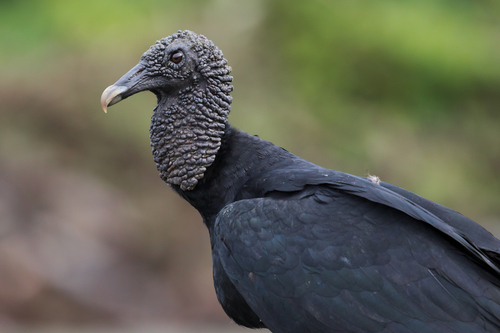
Black Vulture
The Black Vulture (Coragyps atratus) is a New World vulture found throughout much of the Americas. Unlike some other vulture species, it relies primarily on sight rather than smell to locate carrion. It plays a critical role in the ecosystem by removing carcasses, which helps prevent the spread of disease. Black Vultures are highly social birds, often seen in large communal roosts, and have complex social hierarchies. Culturally, they are sometimes viewed negatively due to their association with death, but they are essential for maintaining healthy ecosystems.
56-74 cm
Length
133-167 cm
Wingspan
Least Concern
Conservation Status
Distribution
The Black Vulture's range extends from the southeastern United States through Mexico, Central America, and most of South America, reaching as far south as central Chile and Argentina. They are largely non-migratory, though some populations in the northernmost and southernmost parts of their range may move shorter distances with seasonal changes.
Lifespan
Up to 25 years in the wild; longer in captivity.
Black Vulture's Habitat
Habitat Types
Open landscapes, Savannas, Grasslands, Shrublands, Forest edges, Urban and suburban areas
Climate Zones
Tropical, Subtropical, Temperate
Adaptations
Black Vultures are highly adaptable to a variety of habitats. They are often found near human settlements, taking advantage of readily available food sources such as landfills and roadsides. They thrive in open areas where they can easily spot carrion from the air.
Variations
Three subspecies are generally recognized: *C. a. atratus* (North American Black Vulture), *C. a. brasiliensis* (South American Black Vulture), and *C. a. foetens* (Andean Black Vulture). These subspecies differ slightly in size and plumage details.
Appearance
Breeding Plumage
Plumage is generally uniform throughout the year.
Seasonal Feather Changes
None
Sex Based Plumage Differences
Males and females have similar plumage.
Notable Features
Black plumage overall, Featherless, grayish-black head and neck, Short, hooked bill, Broad wings for soaring, Short, square tail
Diet and Feeding
Primary Foods
Carrion (dead animals)
Foraging Behavior
Black Vultures primarily locate food by sight, often soaring high in the air to scan for carcasses. They may also follow Turkey Vultures, which have a keen sense of smell, to food sources. Black Vultures are aggressive feeders and can often displace other scavengers.
Specializations
Their featherless head and neck are adaptations to prevent soiling while feeding on carcasses. Strong stomach acids help them digest decaying meat and kill harmful bacteria.
Seasonal Diet Variations
Dietary variations are minimal, as carrion is available year-round. However, they may consume more roadkill during certain times of the year due to increased animal activity.
Behavior
Social Structure
Black Vultures are highly social birds, often forming large communal roosts, especially outside of the breeding season. These roosts can contain hundreds or even thousands of birds.
Communication
Hisses, Grunts, Wing-flapping displays during feeding disputes, Body postures to signal dominance or submission
Migration
Generally non-migratory, although some populations at the extreme northern and southern ends of their range may make short-distance movements in response to food availability or weather.
Territorial or Group Behaviors
While not strongly territorial, Black Vultures will defend feeding sites aggressively. They establish dominance hierarchies within flocks, with larger, older birds typically dominating access to food.
Conservation
Threats
Habitat loss, Lead poisoning (from ingesting lead shot in carcasses), Collisions with vehicles, Persecution by humans (due to perceived threat to livestock), Pesticide exposure
Protection Programs
Migratory Bird Treaty Act (in the United States), CITES Appendix II (regulating international trade), Local conservation efforts focused on habitat preservation and reducing human-wildlife conflict
Local National Laws
Protected under various state and national laws in many countries within their range.
Population Trend
Stable
Population Estimates
Global population estimated to be in the millions.
Interesting Facts
They lack a syrinx, the vocal organ of birds.
This means they can only produce hisses and grunts, unlike most other birds that can sing.
They often defecate on their legs.
This behavior, called urohidrosis, helps them cool down through evaporative cooling.
Black Vultures have excellent eyesight
They have excellent eyesight, which is their primary way of finding food.
Faqs about Black Vulture
Are Black Vultures dangerous to humans?
No, Black Vultures are not typically dangerous to humans. They are scavengers and play an important role in the ecosystem. They may become aggressive if they feel threatened, but attacks on humans are extremely rare.
Do Black Vultures spread disease?
Black Vultures actually help prevent the spread of disease by consuming carcasses that could otherwise harbor pathogens. Their strong stomach acids kill most bacteria and viruses.
Why do Black Vultures gather in large groups?
Communal roosting provides several benefits, including increased safety from predators, improved thermoregulation, and information exchange about food sources.
What is the difference between a Black Vulture and a Turkey Vulture?
Black Vultures have black heads and rely on sight, while Turkey Vultures have red heads and a good sense of smell. Turkey Vultures are also slightly larger and have a more teetering flight pattern.
Copyright @ Nature Style Limited. All Rights Reserved.
 English
English